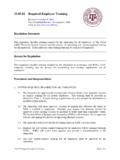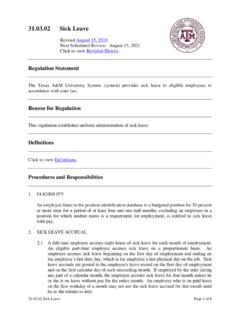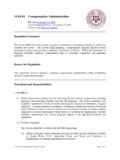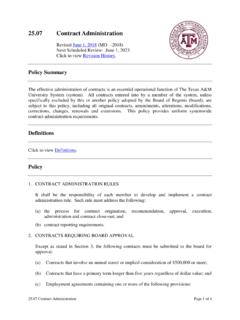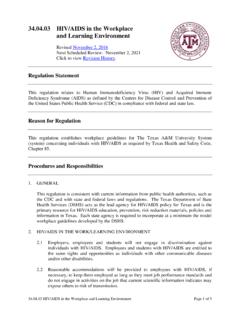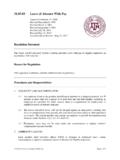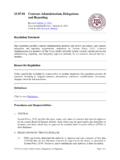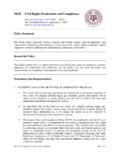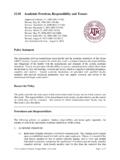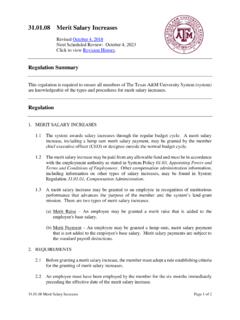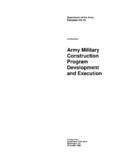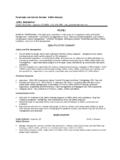Transcription of 24.01 - Risk Management - Texas A&M University …
1 Risk Management Revised February 8, 2018 (MO -2018). Next Scheduled Review: February 8, 2023. Click to view Revision History. Policy Summary It is the objective of The Texas A&M University System (system) to manage, control and, where appropriate, reduce or eliminate risk to the end that its employees, students and visitors are protected from hazards, its financial condition is not seriously jeopardized, and its material and natural resources conserved to the maximum extent possible and practicable. This policy establishes uniform programs and approaches in addressing the risks faced by the system. These programs will provide effective ways to manage, eliminate, or transfer these risks .
2 Policy 1. GENERAL. The system and its members are exposed to risks of loss resulting from injury or death of employees, students and the public; damage to the environment; and loss, destruction and damage to its own property and the property of others. Of primary importance in all risk Management programs is the protection of the health and safety of students, employees and visitors to any member. Strong risk Management and safety programs, coupled with safety consciousness and awareness on the part of all system personnel, are of vital importance to the accomplishment of the objectives of this policy. System Risk Management is responsible for the administration of a risk Management program within the system.
3 The office will oversee programs in environmental Management , health and safety, workers' compensation, risk transfer, and loss prevention. In providing service to the system, System Risk Management will: (a) advise and assist member chief executive officers (CEOs), or their designees, in regard to managing the risk of the member;. (b) facilitate member environmental Management and health and safety programs, and other risk Management programs through such means as, but not limited to, leadership, specialized knowledge, dissemination of current information, or assistance in securing of specialized expertise or equipment;. Risk Management Page 1 of 8. (c) prepare and submit an annual report on the system's risk Management programs to the Board of Regents (board), chancellor and member CEOs.
4 (d) develop and provide professional training opportunities for risk Management personnel utilizing system and outside expertise; and (e) consult with the System Office of General Counsel (OGC) on all legal issues pertaining to the administration and operation of the risk Management programs. 2. HEALTH AND SAFETY. As provided by Executive Order GWB 95-8 (Relating to Workplace Safety and Health of State Employees, Citizens Served, and Preservation of State Property), the system and its members will develop and maintain a comprehensive health and safety program. System Risk Management will provide oversight and guidance for the members' health and safety programs based on federal and state laws and agency regulations.
5 As part of the system's health and safety program, System Risk Management will offer assistance as necessary, including training, to foster member compliance. Each CEO will implement and administer a health and safety program and will submit an annual report to System Risk Management on the status of the member's health and safety program. The chancellor or designee may contract with external providers specializing in health and safety, who will monitor members' compliance with health and safety laws, offer recommendations to the members on how to achieve compliance and report to System Risk Management on the members' progress. 3. INSURABLE RISK. The board, as fiduciary of the assets of the system, recognizes the importance of mitigating risk that may impact the system resources.
6 These risks can come in the form of potential loss of property, potential financial liability, and potential reputation risks . The objective of this policy is to ensure that insurable risks are evaluated and coverage is secured, where applicable. Institutions of higher education may purchase insurance covering the institution and its employees against liability, risk, or exposure and covering the losses of any institutional property, utilizing funds from the institution as authorized in Chapter 51 of the Texas Education Code. In the purchase of insurance, the members will benefit from leveraging the collective purchasing power of the combined members. All insurance protecting the system or its members must be purchased through System Risk Management after a risk assessment has been completed to determine both the necessity and type of coverage best suited to cover the targeted risks .
7 There are two primary types of insurable risk: Insuring the physical assets against financial consequences of property loss is essential in ensuring that the mission of the system is carried out with as little interruption from property loss or damage as possible. Risk Management Page 2 of 8. Insuring against civil liability that may occur in the carrying out of the mission of the system. System Risk Management is responsible for assessing the various insurable risks which face the system. This assessment will consider the potential financial consequences of the risk together with the potential likelihood of an occurrence which would result in financial consequence.
8 Actuarial analysis may be conducted to determine the expected loss exposure, utilizing external actuarial consultants where appropriate. The assessment will consider the potential financial exposure from: (a) Physical harm to employees, students, visitors, or the general public;. (b) Damage to third party property;. (c) Damage to system property;. (d) Contractual liability; and (e) Reputation risk. Management of the impact of these potential risks will utilize various forms of risk avoidance and mitigation with the goal of eliminating or reducing the potential financial exposure to an acceptable level. Management of the impact of the potential financial risk will include, but is not limited to: (a) Reviewing whether the applicable risk is a consequence of the mission of the institution.
9 (b) Mitigation of the exposure through proper oversight and procedures;. (c) Use of waivers and releases developed by OGC);. (d) Coverage of any potential exposure through insurance requirements on third parties utilizing system facilities or programs, and;. (d) Retention or transfer of the remaining loss exposure. System Risk Management will make recommendation on the most appropriate manner in which to receive proper coverage of the loss exposure. The loss exposure may be covered through retention by the member, a shared risk plan, risk transfer through commercial insurance coverage, or some combination thereof. Recommendations will be based on: Financial ability of the member to retain the exposure and/or meet the deductible obligations for the insurable risk will be determined by the member chief financial officer (CFO) and confirmed by the system.
10 Unrestricted assets committed to funding insurable exposures will be moved to restricted reserves at the member level. In determining the decision to retain or transfer the exposure, the likelihood and severity of the potential loss exposure will be evaluated along with an analysis of economic trade off of current premium paid versus expected loss. Risk Management Page 3 of 8. Loss exposure from an insurable risk will be covered at the individual member level if dictated by the uniqueness of the respective risk to the member. Inherent in the shared risk plans covering multiple members is the sharing of risk through the loss history, exposure profile, mitigation programs, and deductible thresholds of the members.
